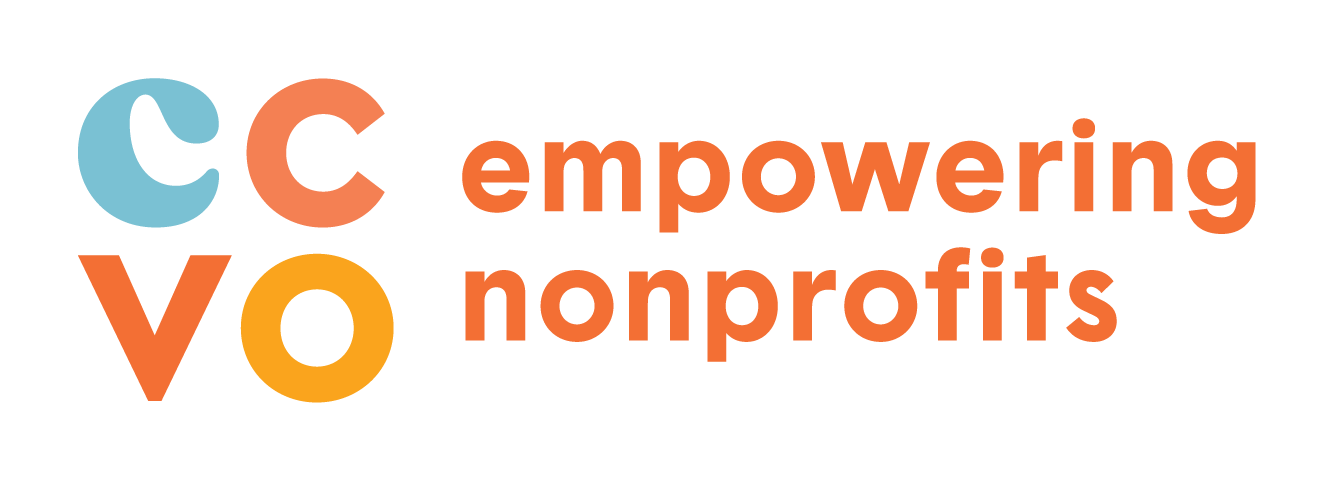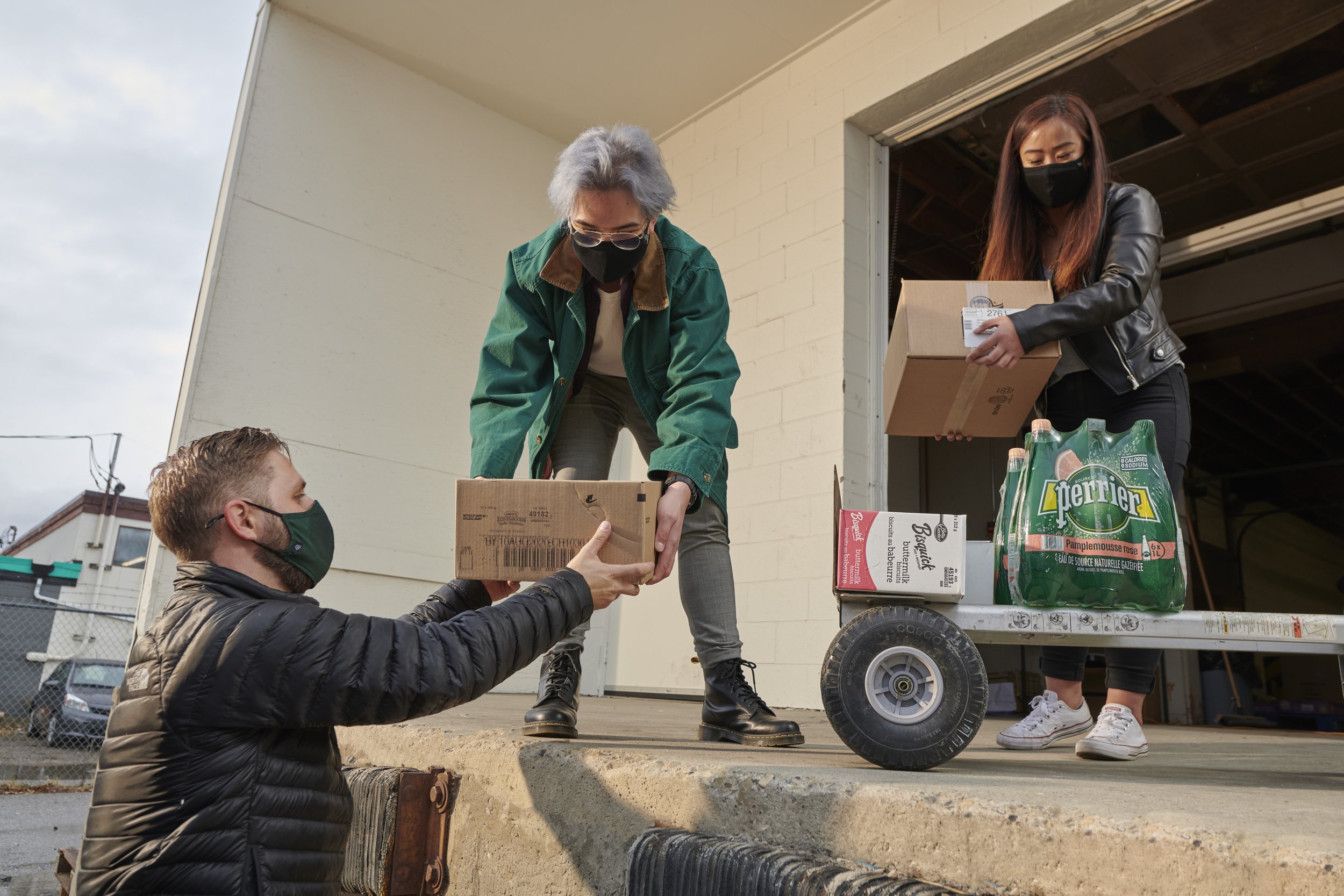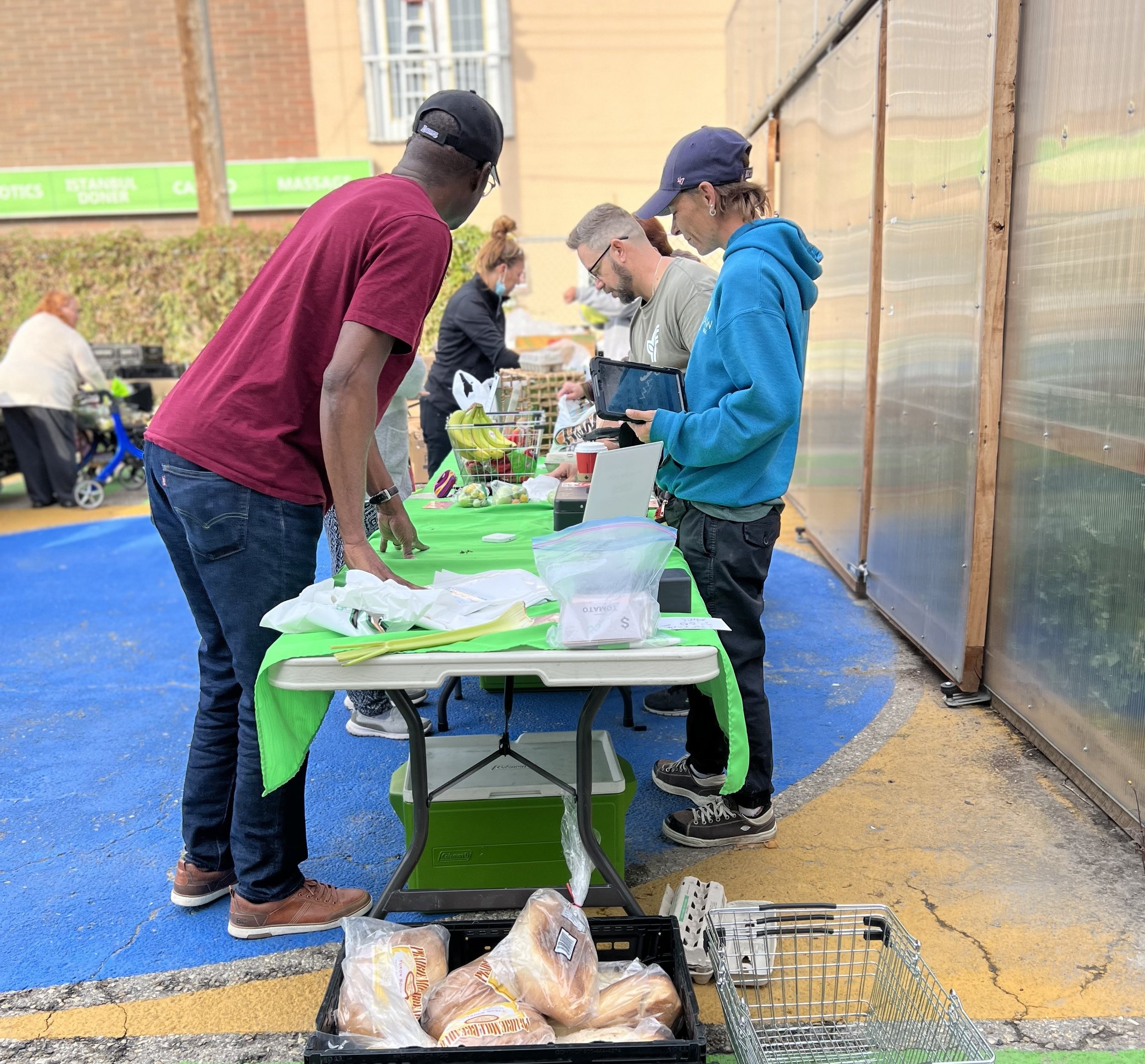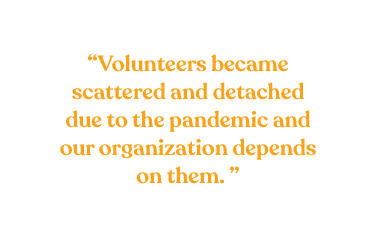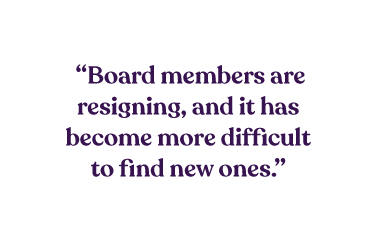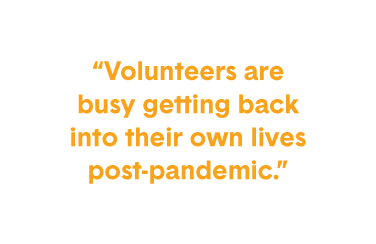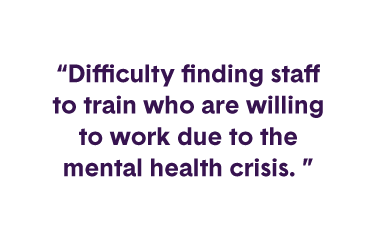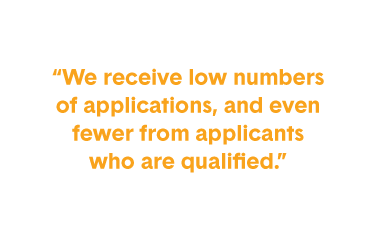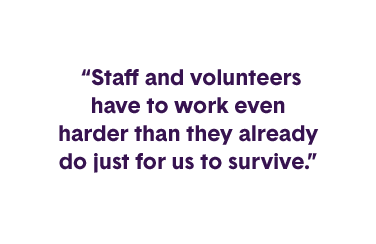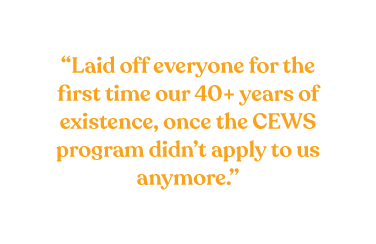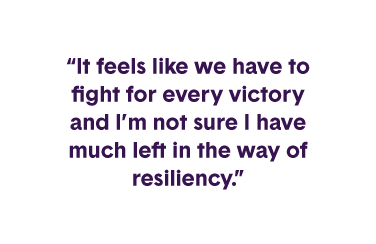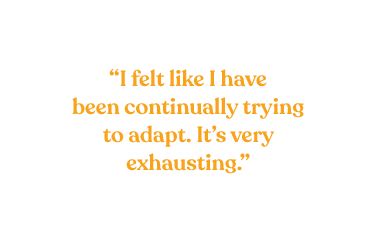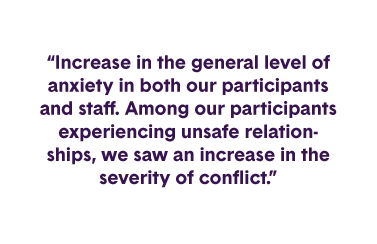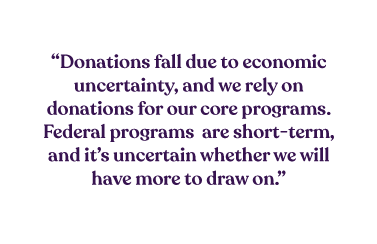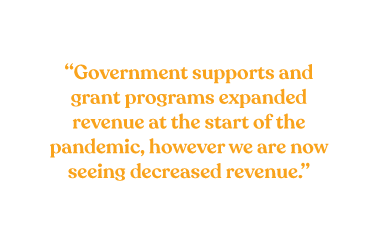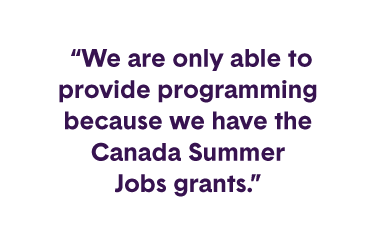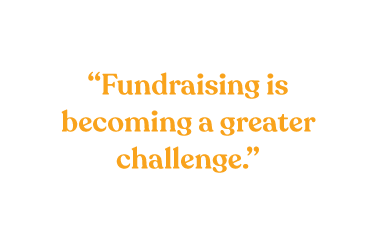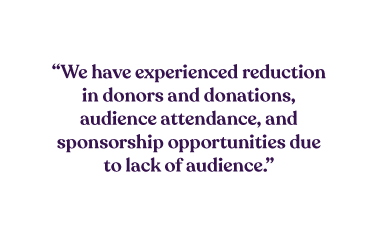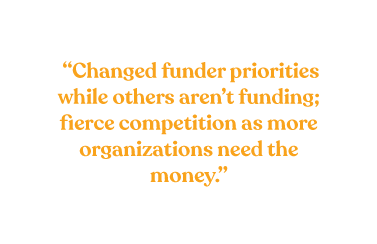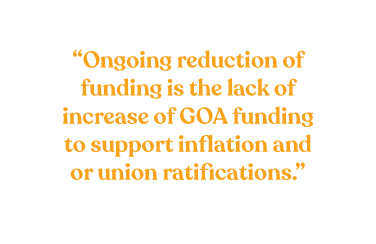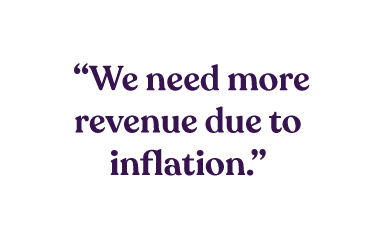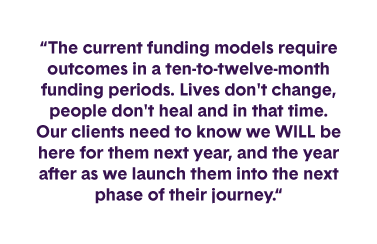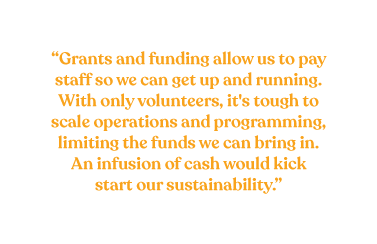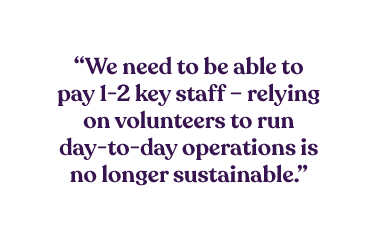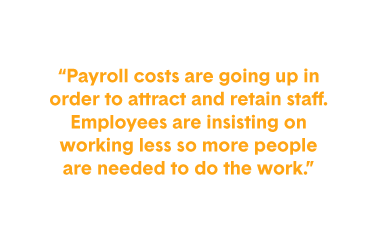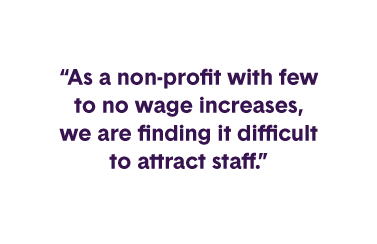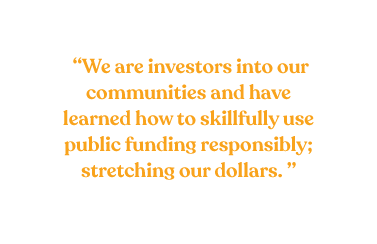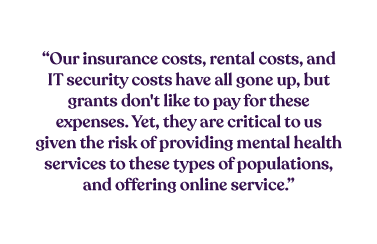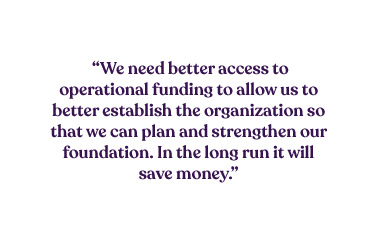Alberta’s Nonprofit Sector:
Too Essential to Fail

Nonprofits are on the front lines – and being sidelined.
While no sector emerged unscathed, nonprofits were particularly under resourced and undervalued through the pandemic. As other sectors recover, nonprofits continue to struggle.
Nonprofits fill critical needs not provided by governments or the for-profit sector spanning poverty reduction, health, mental health, environmental protection, cultural and language support, sport and recreation – and more (see Figure 1). They contribute $5.5 billion to the economy, leverage astounding added value at 227 million hours of annual volunteer time, and employ 1/20 Albertans.
But recent analysis on the sector shows many organizations face uncertainty and instability in the wake of the global pandemic. They are experiencing higher demand for their services and higher complexity of community needs - all while adapting to a new context with fewer resources.
Some benefits are reported: nonprofits became more technologically savvy, and through online engagement, were able to reach new demographics. The pandemic increased public awareness of inequities that have always existed along socio-economic, racial and gender lines, and highlighted the leadership role nonprofits must play in response. But this sectoral evolution requires resources, which are in short supply
Until now, data on the impacts of the pandemic has reflected the sector as a whole. There has been no way to understand impacts in the sub-sectors, which is essential to successful response, recovery and rebuilding strategies.
CCVO is changing that. CCVO is now the holder of the most comprehensive list of nonprofits in Alberta. It conducted a survey of 331 Alberta nonprofits and engaged in a literature review to better understand the impacts of the pandemic on the nonprofit sector.
This report synthesizes our findings, revealing a sector that is under strain and undervalued.
CCVO is calling for immediate relief for the sector, with longer-term priority items to be released in the new year. An emergency cash injection cannot wait: a strong Alberta recovery is one with a plan to support the essential services we rely on every day, while making sure no one is left behind.
Our sector needs a seat at the table as supported partners in the government’s recovery plan. You can help support our sector with one click that sends a note of support to your MLA, Premier and Leader of the Opposition.
CCVO is now the holder of the most comprehensive list of nonprofits in alberta
CCVO commissioned a data set that includes previously unaccounted for organizations. Information in this report reflects that data set, as well as a literature review and CCVO survey of Alberta non-profits with 331 respondents on the effects of the pandemic on nonprofits.
Alberta’s nonprofits fill critical needs in our communities: from food provision and basic needs, to settlement and senior supports, sports and recreation, arts and culture, entrepreneurship, environmental health – and more.
The sector is an irreplaceable source of innovation: it solves complex problems, collaborates creatively, and adds value in our communities. It is difficult to imagine what Alberta would look like without nonprofits – but we have started to document what Alberta looks like with them .
Employing over 285,000 people in Alberta - 78% of whom are women - the nonprofit sector contributes $5.5 billion to our GDP while leveraging an astounding 227 million volunteer hours annually. If this volunteer labour were conservatively valued at $21/hour, it amounts to nearly another $5 billion. The over-representation of women in the sector cannot be ignored, during our recovery and beyond. A vulnerable sector means women are more vulnerable - and that their time, and the activities of the nonprofit sector, is still under valued.
Nonprofits are so fundamentally Albertan that they predate our establishment as a province. They emerged from rural areas where citizens had to problem-solve together to get by.
Alberta has always known: a strong nonprofit sector means better economic, social, cultural and environmental outcomes for Albertans.
Alberta nonprofits predate our establishment as a province. Today, of the 30,000 nonprofits across Alberta, about a quarter of nonprofits are in rural areas and account for 15.3% of nonprofit employees.
The NonProfit Vote is sharing stories from nonprofits that support Alberta.
The State of Alberta’s
Nonprofit Sector

Under Strain: A Sector in Crisis
The current labour crisis in Alberta includes the nonprofit sector: retaining staff and finding qualified new candidates is more challenging in 2022.
At play are lower revenues, thin operating budgets, stagnant contract agreements, rising inflation, mental health challenges among staff, and increased pressure on employees to meet increasing demand for services from the community with fewer resources. The persistent gap between capacity of organizations and demand for services and programs raises questions of how the sector will cope moving forward.
Service Demand and Complexity of Needs are Increasing while Capacity is Decreasing
SURVEY SAYS
Overall challenges:
74%
Identify increased need and complexity of people / communities served
42%
Identify temporarily suspended operations for a period during the pandemic
68%
Identify increasing demand for services
41%
Identify ongoing reduction of capacity to provide needed services/operations
Albertans are struggling in the wake of the pandemic, and nonprofits are seeing it on the front lines - experiencing not only higher demand for services, but higher complexity of client needs. Increasing call volumes to Alberta’s Help Line (211) over the last 3 years attest to these increasing struggles. The biggest demand from Albertans has been in the areas of Mental Health & Substance Use and Criminal Justice & Legal Services, followed by Community Services, Basic Needs, and Income Support.
At the same time, nonprofits had their operations disrupted by downsizing, significant layoffs, and health and safety risks for individuals working on the frontline. Many had to cancel fundraising and other types of events, impacting their finances and ability to network and connect with peers from other nonprofit organizations. As a result, communities went without services and access to community, which took a toll socially, mentally, and physically. Organizations are now working hard to recover connections in an environment where their capacity to function has been diminished and demands are growing.
Many organizations made essential shifts to virtual services and programming. As restrictions are lifted, organizations must once again shift to meet changing circumstances, needs, and wants of the communities they serve. Some clients, for example, remain without access to technology and with limited digital literacy, while demand for services to continue this way is still high. Re-engaging communities, partners, and audiences will take time and concerted resources. Meanwhile, organizations are still struggling to reestablish operational funding that would support staff recruitment and rebuilding lost connections.
"[We're seeing] increased complexity of clients served and the need for wraparound services to meet all the needs of the clients despite loss of funding for many resources province wide. Working with increasingly complex needs of clients with fewer resources will persist for the foreseeable future." - Survey Respondent
A Labour Market in Distress
Workforce issues have remained a consistent challenge for organizations over the course of the pandemic and those issues are not easing. Nonprofits are experiencing lower capacity and productivity among staff and volunteers; more absences; more mental health challenges; and lower budgets to hire staff back with sufficient hours and compensation.
At the start of the pandemic, organizations reported staff and volunteer absences due to fear over catching COVID-19 as well as workforce challenges in shifting to remote work. Organizations began to pay more attention to staff mental health and the supporting role employers could play in a global pandemic. Gradual decreases in the workforce through lay-offs and recidivism have led to concerns that reductions could remain consistent - while lower volunteer rates further limit organizational activity. Reports from Alberta nonprofits indicate their capacity to re-engage volunteers lost during the pandemic has not recovered - volunteers who are also experiencing the strain and stress of the pandemic. Re-engagement is proving exhausting and the resources are limited to do so.
As organizations consider re-hiring they are reporting difficulty in finding and keeping staff. While many organizations report they plan to increase wages, thin operating budgets and funding agreements make this a challenge. This comes at a time when government supports, such as the Canada Emergency Wage Subsidy (CEWS) and the Canada Emergency Rent Subsidy (CERS), are no longer available, and at a time of rising inflation. Nonprofits are apprehensive about their ability to keep up. They cannot pass on prices to clients like for profit businesses, and increased demand is expected to continue. The end of Canada Emergency Response Benefit (CERB) also put pressure on nonprofits that serve populations struggling to meet basic needs. This persistent gap between capacity of organizations and demand for services and programs raises questions of how the sector will cope moving forward.
The persistent gap between capacity of organizations and demand for services and programs raises questions of how the sector will cope moving forward.
While nonprofit employees provide for their communities, it is essential that their needs are met. Nonprofits in Alberta report fatigue, anxiety, and frustration among staff, clients, and volunteers. Statistics Canada surveyed 46,000 Canadians, of which 52% of participants indicated their mental health was either “somewhat worse” or “much worse” since the beginning of physical distancing measures. The realities of the COVID-19 pandemic have also impacted the mental health of many nonprofit employees due to an increase in economic stress, anxiety, social isolation; additional responsibilities such as childcare and an increase in workload; loss of job security due to organizational financial loss, layoffs of colleagues, remote work, and COVID-19 related losses.
The realities of the COVID-19 pandemic have also impacted the mental health of many nonprofit employees.
52% of Canadian participants indicated that their mental health was either “somewhat worse” or “much worse” since the beginning of physical distancing restrictions.
SURVEY SAYS
Challenges related to staff:
71%
Identify negative impacts on staff mental health and well-being
55%
Identify concerns about retaining staff
42%
Identify persistent reduction of volunteers that is still a concern
53%
Identify concerns about recruiting new staff
VOICES FROM THE NONPROFIT SECTOR
Under Resourced: A Sector Being Left Behind
Persistent reduced revenue and ongoing uncertainty created by the pandemic have nonprofits uneasy about their long-term sustainability.
Figure 2 is a comparison of revenues from 2019 to 2020. It captures financial impacts at the start of the pandemic, including service areas – such as Food and Basic Needs, Mental Health, Crisis Response, and Shelter & Housing - that received early pandemic support. Qualitative survey responses tell us those early pandemic supports have now evaporated. Organizations that saw a revenue decrease - in service areas like Sports and Recreation, Social Support (including seniors, disability supports, violence, and daycare), Environment, Transportation, and Arts - may be faring even worse now. Corresponding data on expenses is not available, but we expect these organizations also decreased their expenses, with impacts on the physical, social, and cultural wellbeing of citizens, through sudden reduced access to physical activities, theatre, music, day cares, senior centres, and family services. All of this disruption in service was a disruption to people’s lives, and to their health and wellbeing. It is no wonder so many are still struggling to regain their footing.
To get a complete picture of the trend over the pandemic, revenue data for 2021 and 2022 needs to be collected and analyzed when available. CCVO plans to pursue support to continue building this data set.
“Our organization had Increased revenue in 2020 due to special pandemic supports which are no longer offered”
Charities whose revenues increased early in the pandemic report those supports have evaporated – while demand for services continues to rise. Organizations who lost revenue – such as sports, environmental and arts organizations – are likely further behind.
The ongoing decline in revenues, despite a small jump later during the pandemic, is leading to questions of sustainability.
Income Instability is Leaving Nonprofits in a Precarious Situation
At the beginning of the pandemic, organizations reported a decline across all revenue sources. Some reasons for these declines were having to pause operations, cancel fundraising events, and lower donations being received. Declines were not felt equally across nonprofits. A review of charities shows that from 2019-2020, revenues increased for organizations providing basic needs and crisis response, while others, such as sports, environmental and arts organizations, saw steep declines.
Declines in revenue have been especially challenging for organizations that rely on earned income. As the financial reality of the pandemic set in and organizations were feeling unsure of how long it would last, there was a sense of pessimism and uncertainty in the future. Organizations needed to fill the gap of the financial impact and began to lay-off employees and reduce working hours.
Government supports and services were often cited as a supportive strategy for organizations, with CEWS being the most commonly mentioned. However, smaller charities and philanthropic intermediaries were less likely to fall within scope for government programs, as well as charities that depend on earned income, gifts, and donations. Further, literature suggests that government supports were not enough or not equally spread, leading to nonprofits to dip into their reserves. The ongoing decline in revenues, despite a small jump later during the pandemic, is leading to questions of organizational sustainability. There is concern that piecemeal solutions from the beginning are not enough to sustain over the long-term, especially as government supports come to an end. Organizations are feeling the uncertainty regarding what the future will hold and how long they can sustain based on how long the impacts of COVID continues.
Survey Says
Challenges faced by nonprofits:
28%
Identify being unable to return to revenue levels prior to the pandemic
36%
Identify loss of provincial supports and benefits
88%
Identify impact of inflation
48%
Identify ongoing reduction of revenue
VOICES FROM THE NONPROFIT SECTOR
Non-profits were not eligible for some of the employee government funding perks, despite being an essential service.
Under Valued and Falling Behind
Nonprofits were not equitably supported through the pandemic by the Government of Alberta. They were eligible for less than half of the Province of Alberta’s pandemic support programs and had to compete with the private sector for these funds.
While the COVID-19 pandemic has taken a toll on the nonprofit sector, many supports made available by government for a broad range of businesses were not designed to specifically support the nonprofit sector. Further, there was a lack of clarity and transparency around how and which nonprofits were being supported by the COVID Recovery Plan Response. The 2020-21 Fiscal Update and Economic Statement from the Government of Alberta showed that, of the approved $1.1 billion increase in ministry operating expenses, the nonprofit sector was potentially eligible for $482 million ($346 million without the additional federal supports). However, nonprofits were in competition with private sector businesses for these supports.
Consider:
Less than 4% of the total funding for the Small Medium Enterprise Relaunch Grant (SMERG) went to nonprofits.
Approximately 7% of the total hires supported by the Jobs Now program went to nonprofits.
The Critical Worker Benefit saw uneven distribution and some nonprofit workers were deemed ineligible for this benefit, even though they provide the same services as for-profit or public providers.
Further, in the 2022 provincial budget, there were no new major investments in Alberta’s nonprofit sector, despite a reported surplus. The most recent fiscal update from the province reports a massive surplus of $13.2 billion. The Community Initiatives Program (CIP) and the Community Facility Enhancement Program (CFEP), two major programs that support nonprofits in Alberta, have seen stagnated investment since 2006 (see Figures 3 and 4). CIP funds increased in 2020 to 2021, but this increase was almost entirely devoted to the Stabilize Program – accounting for $19 million in 2020 and $11.6 million in 2021. Phase One of this program was only available to organizations, including for-profit, requiring event venues, such as sports and performing arts organizations. Phase Two of the Stabilize program was only open to nonprofit owner/operators of live experience venues and some micro-grants to artists and return to play funding for children and youth.
Total funding requests to the the Civil Society Fund were 22 times the available budget, with fewer than 1/10 applicants selected . In Round 1, 21 projects of 490 applications were funded, with approximately $7 million in funding allocated of nearly $240 million requested. In Round 2, 37 projects of 295 applications were funded, with $7 million in funding allocated of nearly $130 million requested. In Round 3, 34 projects of 268 applications were funded, with $6 million in funding allocated of nearly $78.5 million requested. And, once again, community nonprofits are competing with post-secondary institutions and private sector organizations for these dollars. Nonprofits in Alberta have been underserved and undervalued as Alberta moves towards recovery.
What looked like a large increase in funding to nonprofits in the Community Initiatives Fund was available only to venue-related organizations involved in sports and performance art.
Under Rapid Change: A Shifting Sector
The pandemic jump-started innovation in the sector, as organizations adapted to new health measures, and remained flexible through on-going change.
They explored diverse ways of collaborating and connecting with target audiences, undoubtedly preparing them for longer term changes in common practice. While nonprofits report many of these shifts as positive, the changes were rapid, and they are still coming. The sector needs support to make them sustainable, to support growth, and to build on these strengths. The nonprofit sector has a major role to play in shaping our collective future as we navigate this massive societal shift.
Innovation, Adaptability and Flexibility
Alberta nonprofits reported similar innovations across the country. The pandemic brought organizations together, working more closely with grassroots and local networks to support communities; it encouraged creative and innovative approaches to executing their missions and to change the workplace such as adopting hybrid models of work; it accelerated changes to funding models, emboldening funders and nonprofits to rethink traditional models and implement changes such as removing spending restrictions on existing grants. These shifts are all positive developments and there are lessons to take from these changes in how nonprofits are funded, encouraged and supported to take risks, and how they are rewarded for working together.
Provided virtual supports to families that will continue as a more effective option going forward.
SURVEY SAYS
Positive changes during the pandemic:
77%
Identify innovating such as creating or adapting new programs, greater organizational focus, working more closely with other organizations
66%
Identify greater adaptability and flexibility50%
Identify shifted to hybrid or full remote work permanently
The attributes of the digital transformation should be pursued and funded so that the sector is not left behind as the world becomes more virtual.
A DIGITAL TRANSFORMATION
The pandemic has forced many organizations to rethink their strategies for how they operate and provide services. It created a growing dependence on current and reliable technology, not just as a luxury but as an essential component for effective operations. A survey of charities by Imagine Canada shows that 42% have created new programs and 54% have transitioned in-person programs to an online format since the beginning of the pandemic. In addition to transitioning programs and services online, nonprofits have made the same transition as other workplaces where possible and have shifted to remote work.
42% of Canadian nonprofits have created new programs and 54% have transitioned in-person programs to an online format since the beginning of the pandemic.
The digital transformation brought tangible benefits. It reduced travel and its associated expenses and emissions. Organizations reported more efficient communication. It removed location-based barriers to participation in nonprofit activities. Volunteers were more available and attended meetings more frequently as a result. Rural populations could be better served and support in the transition was and continues to be needed. For example, nonprofits reported that technological challenges caused losses in engagement and effectiveness.
The impact of the digital transformation on the quality of dialogue and relationships is more nuanced. In-person meetings and interactions allow for informal conversations and networking. Online meetings are more structured and do not allow for informal interaction, which hampers communication. These informal conversations fostered organic sharing of ideas, resources, needs, and collaborations. There are limited funding opportunities to create digital infrastructure of this kind, and historically, nonprofit organizations have been a low priority in terms of receiving funding. The nonprofit sector, and particularly nonprofits in rural areas, will need tools to support organizations as they make this transition to an increasingly online era.
At its best, a digital transformation can help the nonprofit make a leap in its ability to serve: to increase productivity, serve more people, contribute to transparency and trust. Digital transformation can also help with automating manual tasks that reduce costly human errors; more robust data security to prevent costly breaches; data insights that enable strategic decisions such as deploying people and assets in a natural or human-made disaster; utilizing cloud-based services to reduce IT staffing overhead; and improving collaboration and productivity by using digitally-connected technologies that result in more efficient and effective nonprofit programs. The attributes of the digital transformation should be pursued and funded so that the sector is not left behind as the world becomes more virtual.
The change to online services has impacted the interest of volunteers in delivering the service. With technical difficulties and other challenges they were becoming frustrated.
Wage gap of 14% still persists in Alberta, which will also be larger for racialized women, women who are newcomers, women with disabilities, Indigenous women, and trans women.
Diversity, Equity, and Inclusion
The pandemic laid bare existing inequities. Headlines reported the disproportionate impacts of the pandemic along income, socio-economic, ethnic and gender lines, highlighting the importance of diversity, equity and inclusion.
Because they work so closely with communities, nonprofits have a leading role in identifying and addressing inequities. They serve diverse purposes, communities, clients and employees. Of the nearly 9000 responses to a recent Statistics Canada survey, 72% of nonprofits reported serving at least two diverse communities and 64% reported serving at least three diverse communities. The most successful nonprofit organizations are thoughtfully composed of individuals with diverse backgrounds, skills sets and leaderships styles.
A vulnerable sector means women are more vulnerable, and that their time, and the activities of the nonprofit sector, is still undervalued.
While nonprofits have a key role to play in DEI, they are underperforming in some areas. Female employees dominate the Alberta nonprofit sector, but Statistics Canada shows their annual wages and salaries remain considerably lower than their male coworkers and the lowest average annual salaries are those of visible minority employees. Other research finds that nonprofit boards are consistently less diverse than the Canadian population.
All orders of government and the private sector look to the nonprofit sector to lead on providing knowledge of first-hand experience, analysis of trends, and interpretation of the research on inequities. Nonprofits are well-positioned to make sense of the impacts on communities that have been created through unaddressed inequities, and their organizations need to be representative of diverse populations to be as effective as possible. As research has shown, resources matter in the ability to achieve this diversity. As the sector learns that DEI is a necessity for a thriving organization, socially, economically, and morally, it must be a priority for nonprofits as well, and they must be supported to make it a priority.
"Equity seeking efforts and awareness need to be maintained and not lost." - Survey Respondent
Immediate Call
for Emergency
Sector Support

The nonprofit sector is rubbing pennies together to meet growing physical, spiritual, emotional, cultural and social demands in their communities. It is time to put gas in the tank.
Just a sliver of Alberta’s $13 billion surplus - less than 1% - can prevent failure within the sector and save millions of dollars on downstream costs. Economic costs are well-documented when communities lose critical supports, in health care, the justice system and the market - that will fall to Albertans and the Government if our sector fails.
Despite their challenges during the pandemic, nonprofits and charities have worked together to provide vital programs and services for everyday Albertans across the province. The pandemic has shown that nonprofits and charities, governments, and businesses can respond quickly in times of emergency and provide support for our communities – and that they are more effective when they work in collaboration with one another.
The nonprofit sector plays a crucial role by providing supports to those that access programs and services on the frontline while also creating jobs for Albertans. With the sector facing mounting challenges such as growing inflation, labour shortages, increased demand, and decreased revenue, it is critical that the Government of Alberta demonstrates an understanding of the importance and unique needs of the sector to support pandemic recovery as both a societal necessity and an economic driver.
Government budgets for nonprofits are not keeping pace with population growth and inflation.
SURVEY SAYS
Alberta nonprofits would like:
95%
Identify increase in operating funding at the rate of inflation
57%
Identify support for diversity, equity, and inclusion work
89%
Identify government supports and funding opportunities eligible to nonprofits only (i.e. opportunities that exclude for-profit organizations)
65%
Identify supports for digital transformation and technology
75%
Identify mental health of community members and staff of nonprofits
64%
Identify supports for innovation
Voices from the nonprofit sector
The Immediate Request to Prevent Failure
Immediate Request for Investment
Emergency stabilization of the nonprofit sector with an immediate investment of $30 million. This investment will provide relief from the impacts of inflation, particularly to support staff and volunteer recruitment and retention. This investment could be run through a mechanism like the Community Initiatives Program in a one-time opportunity, eligible to nonprofits only (regardless of current grant holding) and without a required matching component.
2. Requests for 2023/24 Budget
i) A commitment to indexing all granting programs to inflation and growth in the budget, starting with 2023/24. For example, that would put CFEP at $70 million and CIP at nearly $58 million for that budget year, and it would put Family and Community Support Services (FCSS) at nearly $130 million, up from the current investment of $100 million that has not seen an increase since 2015.
Ii) An investment in the 2023/24 budget in a strategic Community Prosperity Fund, eligible only to nonprofits totalling $300 million over 3 years, with first year priorities focused on relief from the ongoing impacts of the pandemic and the historic under-resourcing of the sector in support of key priority areas: recruitment and retention of staff; digital transformation; mental health programs for staff and volunteers; and Diversity, Equity and Inclusion.
With these commitments, the Government of Alberta is creating jobs and improving the sustainability of the sector that has felt the impacts of inflation, reduced ability to generate income, and chronic underfunding. There is no economic recovery without community recovery. The provincial government is best positioned to address the problem most succinctly and efficiently, given the urgency of the action that needs to be taken.
Take action as an active supporter and give a voice to Alberta's essential nonprofit sector.

About The Nonprofit Vote Campaign
Alberta’s nonprofits touch thousands of lives every single day, providing critical supports and contributions that keep our communities vital and vibrant.
With approximately 30,000 nonprofits across Alberta contributing more than $5.5 billion in GDP and employing over 285,000 employees, Alberta’s nonprofit organizations are more than vital contributors to Alberta’s economy; they also contribute to the social and cultural fabric of the province by providing key services for Albertans.
In early 2021, the Calgary Chamber of Voluntary Organizations (CCVO) hosted facilitated discussion groups across the province, where numerous leaders from the nonprofit sector expressed the need for a platform that supported a unified voice for the sector. The Nonprofit Vote is that platform – one that illustrates the strength and impact of Alberta’s 26,000 nonprofits, while advocating for the support needed to allow them to continue the delivery of key services and community supports throughout the province.
Acknowledgements
AUTHORS
Alexa Briggs, Karen Ball, Kirsten Boda, Jamie Little, Celia Lee
FUNDERS
Thank you to the Funders, who generously supported the research for this report.
ABOUT CCVO
CCVO (Calgary Chamber of Voluntary Organizations) is a member-based charitable organization that was established in 2004 to strengthen Calgary’s vibrant nonprofit/voluntary sector, and address sector-related public policy issues in Alberta. The high quality of life enjoyed in our communities is built on many of the programs, activities, and services run by more than 26,000 nonprofits and charities that make up Alberta’s nonprofit sector. We are proud to support these organizations through our sector research, advocacy, and informed convening and programming activities.
LAND ACKNOWLEDGMENT
In the spirit of reconciliation, we honour and acknowledge the traditional Treaty 7 territory and oral practices of the Blackfoot Confederacy (Siksika, Kainai, Piikani); the Tsuut'ina; the Îyâxe Nakoda Nations; and the Métis Nation (Region 3); whose footsteps have marked these lands for centuries.
